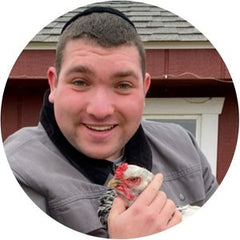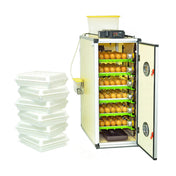Table of Contents
Quail are so easy to raise and hatch that it is inevitable that you will start breeding them. Each breeder will have different goals for their flock. In this article, I will cover all aspects of how to breed coturnix quail, from selecting breeders to incubating eggs to evaluating offspring. This article is full of information for the quail breeding novice and the products you will need to be successful in your endeavor.

Breeding Coturnix Quail
Before you begin breeding quail you need to outline your breeding goals. Whether you are focusing on coturnix quail egg production, body size, egg color, or feather color, certain traits should always be selected when choosing breeding stock. The most important traits to select for in quail are disease resistance, welfare, body size, feed efficiency, temperament, correct color, fertility, and egg production. The top traits I select for when breeding quail are disease resistance, vigor, strong legs, calmness, good temperament, and fertility/egg production.
It is also important to select birds with good body type, calm demeanors, tameness, large eggs, large body size, appropriate color, etc. The accepted male to female ratio when breeding quail is one male for four to five females. Breeding ratios like this assure that the male won't over-mate the hens. Keeping a male with more than five hens will lead to lower fertility in your eggs. It is best not to keep multiple males with multiple females. The males can get territorial and fighting can occur. Overstocking of quail of any gender will lead to aggression and waste accumulation issues.

Housing Breeding Quail
Quail breeding setup is a crucial part of whole process. Quail kept for the production of fertile eggs are best kept in a ratio of one male to four or five females. This will ensure that the hens don't get over-mated and that fertility remains high. Quail are ground-dwelling birds and I have found the best way to house them is in a Hatching Time quail cage. I have housed quail in multiple setups and by far they are the calmest in the Hatching Time cages. The height of the ceiling gives them a sense of security. Droppings fall away from the quails' feet keeping them and their eggs clean. Each breeding group of quail should be housed in a separate compartment. Hatching Time offers quail cages with removable walls so you can house larger groups of quail in a single level for breeding. Keeping breeding records on your quail is a great way to chart your progress over multiple generations. Breeding notes should include: age at first egg, annual egg production, average egg size, weight at ten weeks, number of eggs set, number of chicks hatched, livability of offspring, date of hatch, etc.

Hatching Quail Eggs & Evaluating Offspring
I like the egg incubators that can accommodate egg turners and have high-quality temperature and humidity gauges when I am incubating eggs. Store your eggs in egg trays as you accumulate eggs to incubate. Sort through your eggs and remove any that are damaged, too old, misshapen, dirty, or out of the size range. For reliable and efficient hatching, quail egg incubators provide precise temperature and humidity control to maximize hatch rates and improve quail breeding success. When incubating jumbo coturnix quail eggs, the best size range to incubate is 13-17 gram eggs. Coturnix Quail eggs require an 18 day incubation period. Set your incubator temperature to 99.5-100.5 F and 45% relative humidity for the first 14 days of incubation. Turn your eggs three times a day, on day 15 the quail eggs enter lockdown. During lockdown the humidity in the incubator is raised to 65-75% and egg turning stops. The eggs should start to hatch on day 18, but it is not unheard of for some quail to hatch late. Once the chicks are dry and fluffy, remove them from the incubator and put them in the brooder. Chicks need to remain in the brooder with supplemented heat for at least 2-3 weeks. At three weeks the chicks should be feathered enough that you can transfer them to quail grow out cages.

Culling
When discussing the culling of livestock, the term is used to designate which animals will not be kept in the group. Culled livestock are not always sent for slaughter, many poultry breeders sell their culls as pet quality or keep them for egg production. When I am evaluating my quail for future breeders, I keep an eye out for any birds that have automatic disqualifications. Any quail with aggressive tendencies, crooked toes, cross-beak, or skittish tendencies gets removed. I have a zero-tolerance policy for aggression in my quail, and aggressive birds are removed as soon as they are identified.
What should you do with your culled quail? As long as the female quail aren't aggressive or have a serious defect they are kept strictly for egg production. Male quail that are not kept for breeding are raised until they are 8-12 weeks of age and then processed for meat. It is always a good idea to keep one spare breeder male for every two to three breeder groups. I keep my spare breeder males with my egg-laying quail hens since I don't hatch eggs from them. Now that you know what is required of quail breeding, it's time for you to get started.
Written by:

Aryeh Wiesel








